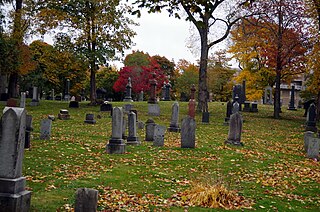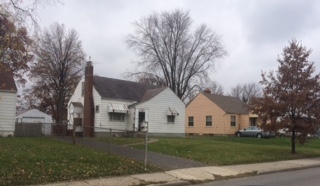
Columbus is the state capital and the most populous city in the U.S. state of Ohio. With a 2020 census population of 905,748, it is the 14th-most populous city in the U.S., the second-most populous city in the Midwest, after Chicago, and the third-most populous state capital. Columbus is the county seat of Franklin County; it also extends into Delaware and Fairfield counties. It is the core city of the Columbus metropolitan area, which encompasses 10 counties in central Ohio. It had a population of 2,138,926 in 2020, making it the largest metropolitan entirely in Ohio and 32nd-largest city in the U.S.

A cemetery, burial ground, gravesite or graveyard is a place where the remains of dead people are buried or otherwise interred. The word cemetery implies that the land is specifically designated as a burial ground and originally applied to the Roman catacombs. The term graveyard is often used interchangeably with cemetery, but a graveyard primarily refers to a burial ground within a churchyard.

Fairview Cemetery is a cemetery in Halifax, Nova Scotia, Canada. It is perhaps best known as the final resting place for over one hundred victims of the sinking of the Titanic. Officially known as Fairview Lawn Cemetery, the non-denominational cemetery is run by the Parks Department of the Halifax Regional Municipality.
Nathan B. Kelley was an American architect and builder. He was a prolific architect whose designs dominated the cityscape of Columbus, Ohio at the middle of the 19th century.

Green Lawn Cemetery is a historic private rural cemetery located in Columbus, Ohio, in the United States. Organized in 1848 and opened in 1849, the cemetery was the city's premier burying ground in the 1800s and beyond. An American Civil War memorial was erected there in 1891, and chapel constructed in 1902. With 360 acres (150 ha), it is Ohio's second-largest cemetery.

North Market is a food hall and public market in Columbus, Ohio. The Downtown Columbus market was established in 1876, and was the second of four founded in Columbus. The market is managed by the non-profit North Market Development Authority (NDMA), which also manages North Market Bridge Park, a market in Dublin, Ohio.

Hilltop is one of the largest neighborhoods in Columbus, Ohio, located west of Franklinton and Downtown. The Greater Hilltop area contains newer and historic neighborhoods, schools, various stores, industrial areas, and recreational facilities. The development pattern is considered a distinct suburb. The majority of the area is predominantly single family residential.

Italian Village is a neighborhood in Columbus, Ohio, that contains an array of residential, commercial, and industrial buildings. It is a designated historic district, known for its historical and cultural preservation. The building types and architecture reflect Italian influence. With its parks and preserved historic homes, Italian Village has the highest home value appreciation in Columbus.

Cheesman Park is an urban park and neighborhood located in the City and County of Denver, Colorado, United States.
Belleville cemetery is a cemetery located in the city of Belleville, Ontario, Canada. Incorporated in 1872, it now covers 65 acres (260,000 m2) along the north shore of the Bay of Quinte.

The English coastal city of Brighton and Hove, made up of the formerly separate Boroughs of Brighton and Hove in East Sussex, has a wide range of cemeteries throughout its urban area. Many were established in the mid-19th century, a time in which the Victorian "cult of death" encouraged extravagant, expensive memorials set in carefully cultivated landscapes which were even recommended as tourist attractions. Some of the largest, such as the Extra Mural Cemetery and the Brighton and Preston Cemetery, were set in particularly impressive natural landscapes. Brighton and Hove City Council, the local authority responsible for public services in the city, manages seven cemeteries, one of which also has the city's main crematorium. An eighth cemetery and a second crematorium are owned by a private company. Many cemeteries are full and no longer accept new burials. The council maintains administrative offices and a mortuary at the Woodvale Cemetery, and employs a coroner and support staff.

Mount Calvary Cemetery is a Roman Catholic cemetery in Columbus, Ohio, located west of downtown next to Green Lawn Cemetery and by the now-abandoned Cooper Stadium. It is the oldest active Catholic cemetery in Franklin County. It is maintained by the Roman Catholic Diocese of Columbus, and has approximately 40,000 interments over 40 acres (16 ha).

Samuel Luccock Black was a Democratic politician from the U.S. state of Ohio who served as 32nd Mayor of Columbus, Ohio for one two-year period and was later a judge.

The Presbyterian Burying Ground, also known as the Old Presbyterian Burying Ground, was a historic cemetery which existed between 1802 and 1909 in the Georgetown neighborhood of Washington, D.C., in the United States. It was one of the most prominent cemeteries in the city until the 1860s. Burials there tapered significantly after Oak Hill Cemetery was founded nearby in 1848. The Presbyterian Burying Ground closed to new burials in 1887, and about 500 to 700 bodies were disinterred after 1891 when an attempt was made to demolish the cemetery and use the land for housing. The remaining graves fell into extensive disrepair. After a decade of effort, the District of Columbia purchased the cemetery in 1909 and built Volta Park there, leaving nearly 2,000 bodies buried at the site. Occasional human remains and tombstones have been discovered at the park since its construction. A number of figures important in the early history of Georgetown and Washington, D.C., military figures, politicians, merchants, and others were buried at Presbyterian Burying Ground.

Briggsdale is a neighborhood of Franklin County in the city of Columbus, Ohio. The neighborhood is on the west/southwest side of the city within the Hilltop area. The area was first settled and founded by the family of Joseph M. Briggs, after whom the neighborhood was named. Joseph Briggs was an active figure in the early years of the township and county operations. The Briggsdale Methodist church was founded with his help, and it now exists as the New Horizons Methodist Church. The present day Briggsdale neighborhood is located near the historical Green Lawn Cemetery to the north as well as Briggs High School to the west.
Columbus, the capital city of Ohio, was founded on the east bank of the Scioto River in 1812. The city was founded as its capitol, beside the town of Franklinton, since incorporated into Columbus. The city's early history was gradual, as residents dealt with flooding and cholera epidemics, and the city had few direct connections to other cities. This led creation of a feeder canal, and later, freight and passenger railroads. The city became known for its industry and commercial businesses into the 20th century, though it experienced a lull in development in the late 20th century. In the 21st century, Columbus has been increasingly revitalized, led by parks projects, new developments, and efforts to beautify individual neighborhoods.

The Merchant Building is a 32-story skyscraper under construction in Downtown Columbus, Ohio. The project formally began in 2016 when the city solicited design ideas; it selected a winning proposal in 2017. Construction began in 2023.

Lone Mountain Cemetery was a complex of cemeteries in the Lone Mountain neighborhood of San Francisco, California, United States on the land bounded by the present-day California Street, Geary Boulevard, Parker Avenue, and Presidio Avenue. Opened 1854, it eventually comprised Laurel Hill Cemetery, Calvary Cemetery, the Masonic Cemetery, and Odd Fellows Cemetery.
New Helvetia Cemetery, initially named Sutter Fort Burying Ground, is a defunct cemetery founded in c. 1845 and closed in 1912, formerly located at northeast corner of Alhambra Boulevard and J Street in the East Sacramento neighborhood of Sacramento, California. It was the first cemetery in the city of Sacramento.
















